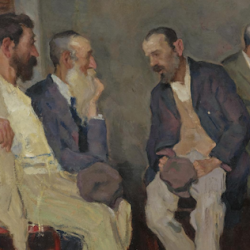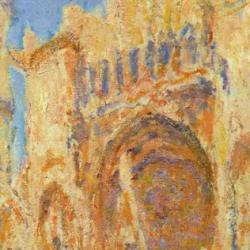Andrew Robinson (God and the World of Signs) cannot prove that C.S. Peirce drew inspiration for his semiotic pattern of Firstness, Secondness, and Thirdness from Trinitarian theology. But Robinson is struck by the parallels between Peircean semiotics and Trinitarian theology.
For starters, he points to similarities between Athanasius’ paradigms of origin and supplementation (the sun cannot exist with its radiance; a spring cannot be a spring without a supplemental flow) and Peirce’s conception of the logical necessity of First to lead to Second and Third.
Robinson explains: “According to Peirce, Firstness – sheer “something” – can be represented by a dot on the paper. However, the dot then divides the paper into two parts, one white and one black, thus introducing the otherness of Secondness. Furthermore, this otherness can be alternatively represented by two separate dots. A line between the two dots would then introduce the category of Thirdness, a form of mediation between the dots” (24).
In short, “the single dot (Firstness) logically implies the concomitant reality of Secondness and Thirdness” (103). Further, “our experience of the world is never an experience of pure Firstness, Secondness or Thirdness is isolation: we prescind Secondness from Thirdness, and Firstness from Secondness, but having placed ourselves in the experiential presence of Firstness we find that Secondness and Thirdness inevitably and continually crowd back in” (103).
Robinson also believes that Peircean semiotics helps us clarify puzzles concerning Trinitarian relations. The “very possibility of relations must arise from within the Trinity and not from outside it” (106). He means that we mustn’t develop a concept of relation-in-general and then apply it to the Trinity. Rather, the notion of relation should itself arise from what we know of the reality of the relations of Father, Son, and Spirit.
When we develop an inner-Trinitarian concept of relation, it becomes clear that “relation” doesn’t describe the same reality. The relation of the Son to the Father is a relation of distinction (like the distinction between dot and surroundings, or dot and dot); the relation of the Spirit is a relation of mediation (like the line connecting the dots).
Thus, Robinson argues, the Son is the source of distinction, the Spirit the source of communion. In a dense formulation: “The Father is not the Son, and the Son is not the Spirit, and the Spirit is not the Father, and all of these negations depend on the otherness that is grounded in the source of otherness, the Son. Similarly, all three persons are in communion with one another, the Father with the Son, the Son with the Spirit, and the Spirit with the Father, and all of these relations of communion are mediated by the source of all mediation, the Spirit. And each hypostasis, which is made distinct from the others by the otherness grounded in the Son, and brought into communion with the others by the mediation grounded in the Spirit, has its own characteristic mode of being, this possibility of having a distinctive quality and character being grounded in the source of all possibility and quality, the Father. There are thus three kinds of relation, Firstness, Secondness and Thirdness, and the co-reality of all three kinds of relation is a necessary and sufficient condition of the reality of each kind of relation as a distinct but not independent hypostasis” (106-7).
That is: Each Person’s uniqueness is grounded in the Father; each Person’s distinctness from the others is grounded in the distinction of the Son from the Father; each Person’s communion with the others is grounded in the Spirit. Without First, Second, and Third, none could be uniquely Himself, nor distinct, not in communion. All three are necessary to the reality of each, and to the reality of the Triune communion itself.
Robinson suggests that this might be close to what Thomas had in mind with his talk of subsistent relations, and finds a parallel with the concept of perichoresis: “we may perhaps summarize this account of the intra-Trinitarian relations by saying that the ramifying interpenetration of the categories that underpins the dynamic processes of semiosis models the ‘being-in-one-another’ of the Trinitarian persons. In short, semiosis models perichoresis” (106-7).











